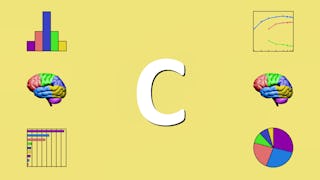"Statistical Learning for Data Science" is an advanced course designed to equip working professionals with the knowledge and skills necessary to excel in the field of data science. Through comprehensive instruction on key topics such as shrink methods, parametric regression analysis, generalized linear models, and general additive models, students will learn how to apply resampling methods to gain additional information about fitted models, optimize fitting procedures to improve prediction accuracy and interpretability, and identify the benefits and approach of non-linear models. This course is the perfect choice for anyone looking to upskill or transition to a career in data science.



Resampling, Selection and Splines
This course is part of Statistical Learning for Data Science Specialization

Instructor: Osita Onyejekwe
Included with 
Recommended experience
Recommended experience
What you'll learn
Apply resampling methods in order to obtain additional information about fitted models.
Optimize fitting procedures to improve prediction accuracy and interpretability.
Identify the benefits and approach of non-linear models.
Skills you'll gain
Details to know

Add to your LinkedIn profile
See how employees at top companies are mastering in-demand skills

Build your subject-matter expertise
- Learn new concepts from industry experts
- Gain a foundational understanding of a subject or tool
- Develop job-relevant skills with hands-on projects
- Earn a shareable career certificate

There are 5 modules in this course
Welcome to our Resampling, Selection, and Splines class! In this course, we will dive deep into these key topics in statistical learning and explore how they can be applied to data science. The module provides an introductory overview of the course and introduces the course instructor.
What's included
6 videos2 readings1 discussion prompt
In this module, we will turn our attention to generalized least squares (GLS). GLS is a statistical method that extends the ordinary least squares (OLS) method to account for heteroscedasticity and serial correlation in the error terms. Heteroscedasticity is the condition where the variance of the errors is not constant across all levels of the predictor variables, while serial correlation is the condition where the errors are correlated across time or space. GLS has many practical applications, such as in finance for modeling asset returns, in econometrics for modeling time series data, and in spatial analysis for modeling spatially correlated data. By the end of this module, you will have a good understanding of how GLS works and when it is appropriate to use it. You will also be able to implement GLS in R using the gls() function in the nlme package.
What's included
1 video1 reading1 programming assignment1 ungraded lab
In this module, we will explore ridge regression, LASSO, and principal component analysis (PCA). These techniques are widely used for regression and dimensionality reduction tasks in machine learning and statistics.
What's included
7 videos3 readings3 programming assignments
This week, we will be exploring the concept of cross-validation, a crucial technique used to evaluate and compare the performance of different statistical learning models. We will explore different types of cross-validation techniques, including k-fold cross-validation, leave-one-out cross-validation, and stratified cross-validation. We will discuss their strengths, weaknesses, and best practices for implementation. Additionally, we will examine how cross-validation can be used for model selection and hyperparameter tuning.
What's included
1 video1 reading1 programming assignment
For our final module, we will explore bootstrapping. Bootstrapping is a resampling technique that allows us to gain insights into the variability of statistical estimators and quantify uncertainty in our models. By creating multiple simulated datasets through resampling, we can explore the distribution of sample statistics, construct confidence intervals, and perform hypothesis testing. Bootstrapping is particularly useful when parametric assumptions are hard to meet or when we have limited data. By the end of this week, you will have an understanding of bootstrapping and its practical applications in statistical learning.
What's included
1 video1 reading1 programming assignment
Earn a career certificate
Add this credential to your LinkedIn profile, resume, or CV. Share it on social media and in your performance review.
Instructor

Offered by
Explore more from Probability and Statistics
 Status: Free Trial
Status: Free Trial
University of Colorado Boulder
 Status: Free Trial
Status: Free Trial
University of Colorado System
 Status: Free Trial
Status: Free Trial
University of Colorado Boulder
 Status: Free Trial
Status: Free Trial
University of Colorado Boulder
Why people choose Coursera for their career





Open new doors with Coursera Plus
Unlimited access to 10,000+ world-class courses, hands-on projects, and job-ready certificate programs - all included in your subscription
Advance your career with an online degree
Earn a degree from world-class universities - 100% online
Join over 3,400 global companies that choose Coursera for Business
Upskill your employees to excel in the digital economy
Frequently asked questions
Access to lectures and assignments depends on your type of enrollment. If you take a course in audit mode, you will be able to see most course materials for free. To access graded assignments and to earn a Certificate, you will need to purchase the Certificate experience, during or after your audit. If you don't see the audit option:
The course may not offer an audit option. You can try a Free Trial instead, or apply for Financial Aid.
The course may offer 'Full Course, No Certificate' instead. This option lets you see all course materials, submit required assessments, and get a final grade. This also means that you will not be able to purchase a Certificate experience.
When you enroll in the course, you get access to all of the courses in the Specialization, and you earn a certificate when you complete the work. Your electronic Certificate will be added to your Accomplishments page - from there, you can print your Certificate or add it to your LinkedIn profile. If you only want to read and view the course content, you can audit the course for free.
If you subscribed, you get a 7-day free trial during which you can cancel at no penalty. After that, we don’t give refunds, but you can cancel your subscription at any time. See our full refund policy.
More questions
Financial aid available,

